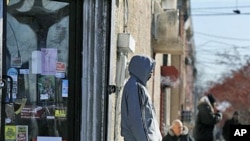Census data released Tuesday show that 46 million people live in poverty in the United States. The 2010 census also shows that a slightly higher figure, almost 50 million people, in the U.S. do not have health coverage.
Related video report by Mil Arcega
Nearly one-sixth of the U.S. population lives in poverty. Garrett Adams, a medical doctor in the southeastern United States, says financial constraints are preventing people from getting the life-saving health treatments they need.
Adams' voice choked with emotion as he addressed federal lawmakers Tuesday. For several minutes, he spoke of people he knew personally, saying there is a cycle in which poverty can be a death sentence and illness can be a poverty sentence.
"Clay Morgan, an automobile mechanic in Henry County, Kentucky, owned his own business. He got malignant melanoma [a form of cancer], was treated, improved, and thought to be cured, but now was bankrupted. Cancer returned. Depressed, and unwilling to bring more medical debt on his family, Clay went into the backyard and took his own life," Adama said.
Dr. Adams founded a not-for-profit medical clinic in a poor area of Tennessee last year. He said he was tired of seeing friends in the mountain town being taken advantage of by for-profit hospitals and deprived of affordable health care.
In 2010, nearly 50 million people in the United States did not have health insurance, a slightly higher number that the previous year. Most of those uninsured are younger than 65, the age at which the government provides health care.
Dr. Adams told U.S. lawmakers that health care options for younger Americans and the working poor are limited, and when they do find care, it can be too late.
"Doris, [age] 58, and her husband operated a small, local restaurant before her illness forced them to close the restaurant. Estimated annual income $13,000. No insurance. No medical care. She heard we offered mammograms. We diagnosed breast cancer. Paula, 32, cervical cancer surgery two years ago, but no follow-up because of no insurance and no money," Adams said.
In the United States, most people who have health coverage have such insurance through their employers.
Robert Greenstein is an economist and president of the Washington-based Center on Budget and Policy Priorities.
"The number of people who are uninsured grew in 2010 due principally to continued erosion in employer-based coverage," said Greenstein.
The unemployment rate in the United States remains above nine percent, as it was last year, and not all employers are required to provide health benefits.
Elise Gould is the director of health policy research at the Economy Policy Institute in Washington. She told reporters that young adults aged 18 to 24 are the least likely to be covered by their employers.
Gould credited recent government initiatives with improving their access to health care.
"Health reform played a key role in stemming the fall of workplace coverage for young adults. The Patient Protection and Affordable Care Act, commonly known as 'health reform', included provisions that allowed young adults up to age 26 to secure health insurance coverage through their parents' employer-sponsored health insurance policies," Gould said.
The officials say one-third of people without insurance live in poverty. According to the 2010 census figures, the official poverty rate was 15.1 percent - up from 14.3 percent in 2009.
In the United States, a family of four is considered to live in poverty if the household income is below about $22,000.
Dr. Tim Hulsey told lawmakers Tuesday that poverty has different meanings throughout the world. A cosmetic surgeon, Hulsey has provided medical care to children with cleft palates in Central America. He described cardboard houses, polluted water sources and no sanitation, which he said can be a death sentence.
Hulsey said in the United States, Americans have opportunities to adopt healthy lifestyles and more care options such as free clinics, charity organizations, and doctors who are willing to volunteer their services, as he does.
"In other words, there is little reason other than failure to seek care that poverty should be a death sentence in this country," Hulsey said.
Economist Greenstein acknowledged to reporters that just as Americans are dealing with health care issues, U.S. lawmakers are dealing with budget shortfalls.
"Even before today's grim figures, the United States had higher degrees of poverty and inequality than most other Western industrialized nations. We need deficit reduction, but it need not make these problems even more severe than they already are," Greenstein said.
While the number of people living in poverty and the number of uninsured are similar, it is not only impoverished people who do not have health insurance.
One-fifth of America's 50 million uninsured have a household income of more than $75,000 a year.













